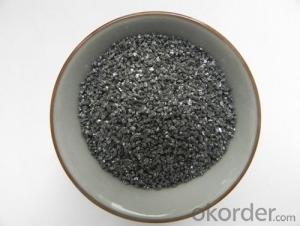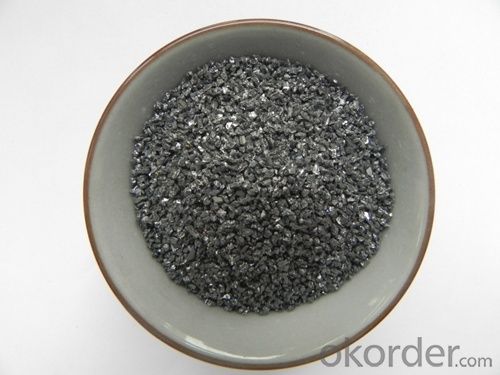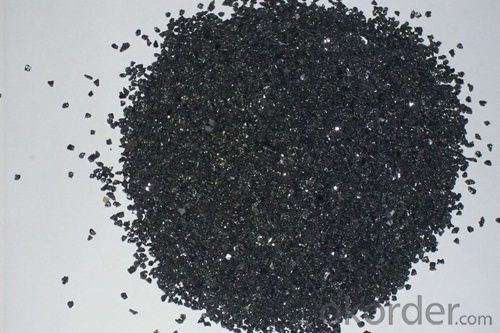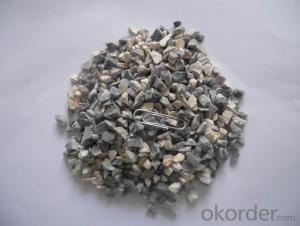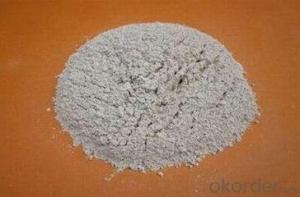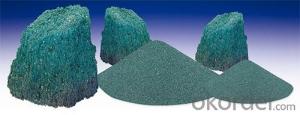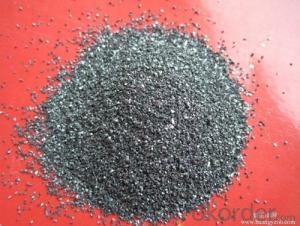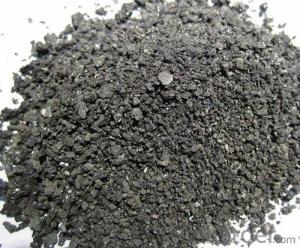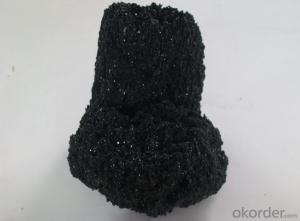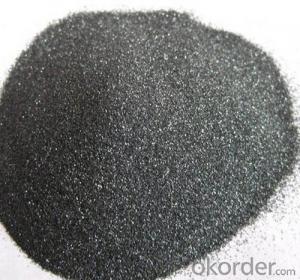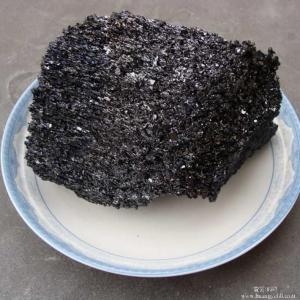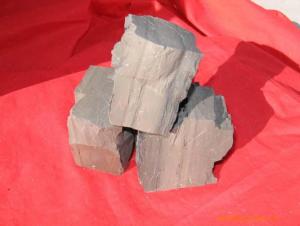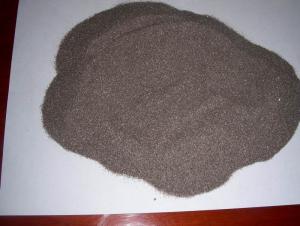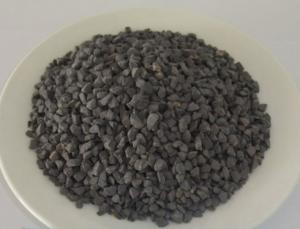Raw Materials for Refractory:Best Price Black Silicon Carbide SIC China Manufacture
- Loading Port:
- China main port
- Payment Terms:
- TT OR LC
- Min Order Qty:
- 25 m.t.
- Supply Capability:
- 2000 m.t./month
OKorder Service Pledge
OKorder Financial Service
You Might Also Like
Free Samples., Contact us Now!
Product Introduction:
Due to chemical stability, high thermal conductivity, low thermal expansion coefficient, good wear resistance, in addition to abrasive use, Silicon carbide can be used in many ways,
1) As abrasive, can be used for abrasive tools, such as grinding wheel, oilstone, grinding, sand tile etc.
2) As deoxidizer and high temperature resistant material.
3) Silicon carbide powder coating on the inner wall of turbine impeller or the cylinder body, to improve and extend the service life of 1 ~ 2 times for its wear resistance;
4) As the single crystal of high purity, can be used for manufacturing semiconductor, silicon carbide fiber.
5) Advanced refractory material, made from which, has thermal shock resistance, small volume, light weight and high strength, and good energy saving effect.
6) Low grade silicon carbide (SiC 85%) is an excellent deoxidizing agent, which can be used to speed up the steel-making, and easy to control the chemical composition, improving the quality of the steel.
7) Silicon carbide is also used extensively for production of silicon carbide heating elements.

Application
1. Grinding wheels
2. Heating elements
3. Coated tools
4. Refractory
5. Polishing ,Lapping
6. Ceramic
- Q: Can anyone tell me what is A-leve fireproof material?
- What you say is probably palstic! B-level means the fireproof rating is at B1-level because palstic material doesn't belong to fireproof materials. It only is fire?retardant. When wholesaling all kinds of insulation materials and construction, it need tos look at the names. B1-level refers to the fire endurance rating of the fireproof material, which is determined according to the fire resistance of the material. In addition, different parts of the material have different fire endurance ratings! You can download a "Specifications of Fireproof Design for Buildings" for further information!
- Q: Procedures for producing common refractory materials?
- The general procedures of producing refractory materials include calcination of raw materials, selection of raw material , crushing, grinding, screening, mixing, ageing mixture, molding, drying, burning and etc. At present, the refractory factory usually purchases the calcined clinker, so the calcination of raw material is no longer a consideration of common refractory plants.
- Q: What is the strength of high strength refractory material?
- Refers to constrcuting through ramming, and a refractory materials that is hardened in temperature higher than normal. mixed through a certain grade of refractory aggregate, powder, binder, additives, water or other liquids. Can be classified into high alumina and fireclay, magnesite, dolomite, zirconium and silicon carbide by the standard of texture.
- Q: What is molten silicon? What refractoriness do refractories made by it have? What properties of using does it have?
- Molten silicon can be called quartz glass, which shows an amorphous silicon state. It is a liquid fusion at above 1723 degree and is an ultra-cooling state at low temperatures. It is not generated in refractories, but generated in the matrix, showing liquid state at a high temperature capable of buffering the stress with somewhat binding properties. If quartz glass is used as refractory, its function are melrly these ones. (These are what I konw for reference only.)
- Q: How to apply the alumina powder on refractories?
- What kind of the refractories can make the aluminium oxide increase the aluminum content and specific gravity, and erosion-resistant.
- Q: What is the offer of fire proofing thermal insulation material?
- The following prices are from the Internet and for your reference only. Hainan fire proofing thermal insulation material ceramic fiber paper aluminum silicate fiber blanket/aluminum oxide fiber insulation cotton insulation pipe 12 yuan Hainan multicrystal mullite/calcium silicate corundum ceramic fiber loose wool short fiber fire proofing thermal insulation material non-asbestos high temperature resistant aluminum silicate fiber insulation cotton fire-resistant material ceramic fiber blanket thermal insulation blanket 28 yuan non-asbestos high temperature resistant aluminum silicate fiber ceramic fiber blanket needled felts insulation blanket fire resistant material thermal insulation cotton blanket reference price: 59 yuan
- Q: what needs to be noted when choosing and using blast furnace fireproof materials?
- Hello,: three parts of the blast furnace lining in general are easily corroded. The first one is furnace bosh,second is the middle part of the furnace, The third is lower part of the furnace stack. if These parts are damaged, then we need an overhaul. Bosh, because damage to the middle part of the furnace and the furnace bosh are generally due to alkali metal and fusant erosion. the main reason for the lower furnace part damage is molten iron, slag. In view of this situation, mullite bricks, corundum bricks, silicon carbide bricks are used for reparation. make repairments as soon as possible if any problems occur in case of incidents.
- Q: can slag tailings be used to be the base materials of refractory materials ?
- perhaps not, because it has many pores.
- Q: Firing high temperature kiln of refractory and internal temperature being as high as 1600 ℃, metal heat exchanger can't use, how to do?
- 1>3>。 When metal heat exchanger is in 700 ℃, it must process high temperature protection, mixed cold wind or cold blast to protect heat exchanger. So this will waste a lot of energy; The comparison of high temperature resistant ceramic heat exchanger using temperature is 1350 ℃ to 1450 ℃; metal heat exchanger using temperature 700 ℃; heat utilization comparison of ceramic heat exchanger can be placed in 1350 ℃ or higher (highest available to 1450 ℃); the oxidation resistance, a very short time will burn out;2 >, waste heat recovery rate is high. Replacing the metal heat exchanger in high temperature and corrosion environment; Comparative ceramic heat exchanger can be used under the condition of 1350 ℃ for a long time. Let's make a comparison, if it is a refractory material industry. <, ceramic heat exchanger is simply won't appear, under the condition of equal to ceramic heat exchanger using, energy saving effect is best, can exchange for the high temperature. <. Ceramic heat can be placed on the nearest of exchanger flue outlet . <, and metal heat exchanger put in place contrast to the ceramic heat exchanger. In the process of using metal heat exchanger, if this situation happens, you can consider the ceramic heat exchanger. Temperature difference is between 650 ℃ to 750 ℃. If the metal heat exchanger is placed in normal place where ceramic heat usually put;The service life comparison: since ceramic heat exchanger with high temperature resistance, this partly replace metal heat exchanger. What's more, energy-saving rate is also different. Metal heat exchanger can be placed in 700 ℃ or less;4 >, corrosion resistance, its application effect is very different. So the metal-heat-exchanger's heat-resistant temperature is high and the service life is the countless times of metal heat exchanger. The place with highest temperature does not need high temperature protection.
Send your message to us
Raw Materials for Refractory:Best Price Black Silicon Carbide SIC China Manufacture
- Loading Port:
- China main port
- Payment Terms:
- TT OR LC
- Min Order Qty:
- 25 m.t.
- Supply Capability:
- 2000 m.t./month
OKorder Service Pledge
OKorder Financial Service
Similar products
Hot products
Hot Searches
Related keywords
